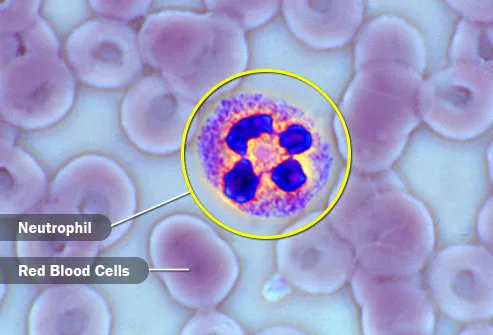How Your Body Fights Infection

What Is It?
This network of tissues, cells, and organs first tries to keep out germs like bacteria, viruses, fungi, and parasites and then deals with them if they manage to get in. If it senses something in your body that could be bad for you, it triggers the release of special cells. These travel to where the trouble is, attack the intruder, and help get rid of it.
Swipe to advance

2
/
20
How Do Infections Spread?
Your body has to be able to stop invaders that come from a lot different places. Germs can come from contact -- touching skin, having sex, and breathing in drops from someone else's sneeze or cough, for example. They can travel through blood that comes from a shared needle or an insect bite. You can also get germs from contaminated food or water.
Swipe to advance

3
/
20
First Line of Defense
Your skin is the most obvious one. It blocks invaders from getting into your body in the first place. Other blockers are the clear layer over the front of your eye (cornea) and specialized tissue that lines your lungs, bladder, and digestive system. A cut, sore, or burn can make an opening in any of these for a germ to get in and infect you.
Swipe to advance

4
/
20
Washing Germs Away
Sweat on your skin, tears in your eyes, and mucus in your nasal passages, digestive system, and a woman's vagina can stop invaders from getting in, too. These liquids your body makes not only push away dirt and germs but also have enzymes that can kill bacteria.
Swipe to advance

5
/
20
Lymphatic System
A network of fine tubes throughout your body collects fluid called lymph from tissues. Part of its job is to pick up dead cells and germs. Waste is filtered out at small bean-shaped lymph nodes, and the liquid goes back into your bloodstream. An infection can make the nodes swell. You may have felt them in your neck when you had a sore throat or cough.
Swipe to advance

6
/
20
Antigens
These are markers that your immune system can recognize. Some, called human leukocyte antigens (HLA), tag your cells so your body can ID itself. Others could be part of a foreign cell or germ, or they may be a substance like food or pollen.
Swipe to advance

7
/
20
Innate vs. Acquired Immunity
When you're born, before your body comes across any unfamiliar antigens, it can defend itself from infection. This innate immunity comes from those barrier body parts as well as some specialized cells. Over time, your immune system "learns" other ways to protect you. Acquired immunity comes from antibodies you get from your mother in the womb or that you make in response to antigens that aren't yours -- like from a cold virus or a vaccine.
Swipe to advance

8
/
20
Bone Marrow
The soft, fatty stuff that lives inside your bones is where your body makes blood cells, including the various white blood cells that fight off germs.
Swipe to advance

9
/
20
Phagocytes
They're part of your innate immunity, and they work by eating invaders. Neutrophils, the most common type of white blood cell, are among the first responders called to a trouble spot. They digest bad cells and can trap bacteria and stop it from spreading. Macrophages grow from white blood cells called monocytes, but they work in tissues, not your blood. Eosinophils mainly attach to parasites that are too big to ingest in order to kill them.
Swipe to advance

10
/
20
Natural Killer Cells
Another part of your innate immunity is this type of white blood cell. They recognize and latch onto abnormal cells like cancer, then damage and kill them. They're key players when you first get infected by a virus.
Swipe to advance

11
/
20
Basophils and Mast Cells
They're also part of your innate immunity, involved with allergic reactions. Basophils are in your blood; mast cells are in tissues. When these cells find certain antigens (typically, harmless things that your body sees as a threat), they release histamine to bring immune cells to the area. Your body sends more blood there, causing inflammation -- redness, warmth, and swelling -- that also helps keeps the invasion from spreading.
Swipe to advance

12
/
20
Lymphocytes
These infection-fighting white blood cells are the reason you get sick from things like chicken pox only once. Lymphocytes called T cells and B cells work together to build your acquired immunity.
Swipe to advance

13
/
20
Antibodies
Once your B cells get a read on the antigen of a new invader, they make antibodies to either kill it or flag it as "Trouble here!" These Y-shaped molecules fit into antigens like puzzle pieces, making an immune complex. An antibody can also be called immunoglobulin or Ig.
Swipe to advance

14
/
20
T Cells
They travel through your blood and lymph systems, waiting to be activated. Usually, another immune cell, like a dendritic cell, will need to break down an antigen so it can be recognized to start the process of making specialized T cells. Killer and helper T cells are part of the search-and-attack team for that antigen. You need suppressor T cells to end the response, and they can sometimes prevent harmful responses from happening.
Swipe to advance

15
/
20
Thymus
After forming in your bone marrow, T cells travel to this small organ behind your breastbone to mature into cells that can tell one antigen from another. It's also here that these cells learn not to attack your body's own tissues, and they normally can't leave until they do.
Swipe to advance

16
/
20
Secondary Lymph Organs
Your spleen, tonsils, adenoids, appendix, and small Peyer patches in your intestine are where mature T cells are stored. These organs can also help sift out germs and dead cells, the way your lymph nodes do. Your immune cells might meet up here to get a closer look at possible threats and figure out the right plan of action.
Swipe to advance

17
/
20
Memory Cells
You may get sick the first time your body comes across a new antigen and is learning how to make antibodies. But afterward, you'll have leftover B and T cells called "memory cells" that can recognize that particular germ and respond quickly.
Swipe to advance

18
/
20
Complement System
It's a group of more than 30 proteins that work in a cascade, where one triggers the next, which triggers another, and so on. These either kill germs directly or "mark" them or their location so that other cells can destroy them. They may help antibodies do their job. They're also part of cleaning up immune complexes, the antibodies attached to antigens. They work with both acquired and innate immune responses.
Swipe to advance
https://www.blogger.com/blogger.g?blogID=7984083478982936067#editor/src=sidebar

19
/
20
Cytokines
Different kinds of cells can make these messengers. Some cytokines trigger and focus the immune response. They might tell white blood cells where to go or how to destroy a particular germ. One type, interferons, can slow or stop a virus from making copies of itself. Cytokines also tell your body to shut it down after a threat is gone.
Swipe to advance

20
/
20
When It Goes Wrong
An allergic response is your body overreacting to something that wouldn't hurt you, like peanuts. When your system doesn't react strongly enough to a problem, that's called an immunodeficiency disorder, like AIDS. An autoimmune response happens when your body mistakes your tissues or organs for invaders and attacks healthy cells. That can cause serious illnesses like rheumatoid arthritis, Crohn's disease, type 1 diabetes, and lupus.
Swipe to advance
- Get link
- X
- Other Apps